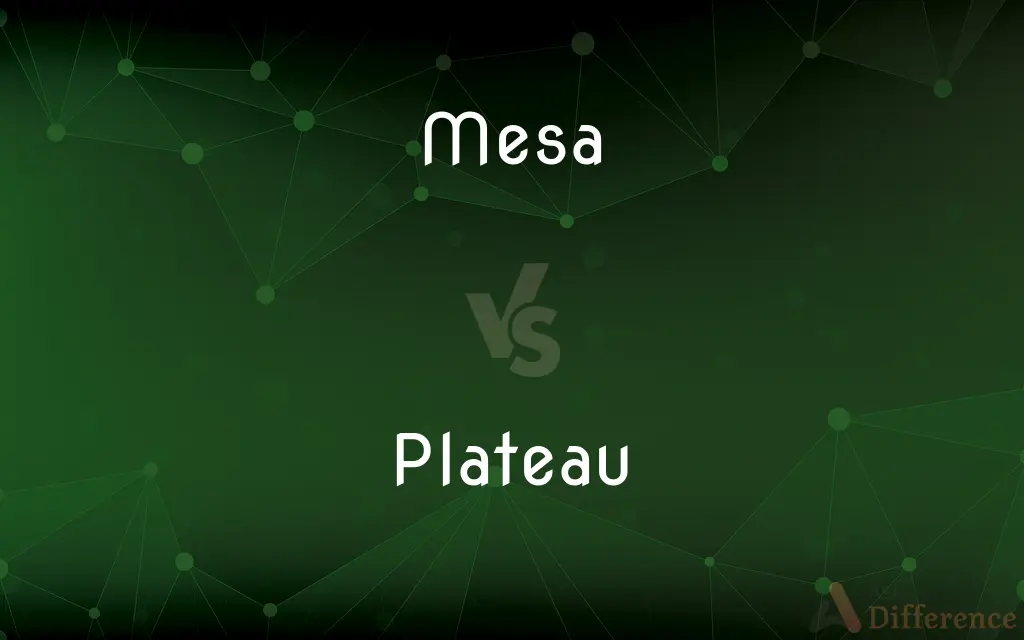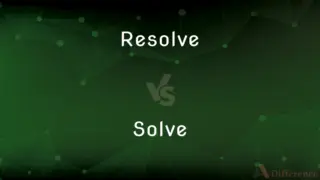Mesa vs. Plateau — What's the Difference?
By Tayyaba Rehman & Fiza Rafique — Updated on September 11, 2023
A mesa is a flat-topped elevated area with steep sides, often smaller than a plateau, which is a larger, flat elevated area that may be broken by erosion or uplift.

Difference Between Mesa and Plateau
Table of Contents
ADVERTISEMENT
Key Differences
Mesa and plateau both describe elevated landforms that are flat on top. However, a mesa is typically smaller in scale compared to a plateau.
Geographically, mesas are commonly found in arid landscapes and are generally formed by erosion. Plateaus, in contrast, can be found in a variety of landscapes and can result from volcanic activity, erosion, or tectonic movements.
In terms of their sides, mesas usually have steep, cliff-like sides due to erosion. Plateaus may also have steep sides but are often not as pronounced, and the edges can be more irregular.
Culturally and historically, mesas have significant roles in Native American civilizations for housing and rituals. Plateaus are often important agricultural areas due to their flat terrain and can be crucial for human settlements as well.
Comparison Chart
Size
Smaller
Larger
ADVERTISEMENT
Formation
Erosion
Various Causes
Sides
Steep, cliff-like
Can be irregular
Location
Often in arid areas
Various landscapes
Cultural Relevance
Native American sites
Agricultural areas
Compare with Definitions
Mesa
In geology, a mesa is often the result of erosional processes.
The mesa was formed by wind and water erosion over millions of years.
Plateau
A plateau is a flat elevated area of land.
The plateau offered a breathtaking view of the valley below.
Mesa
Mesa is a flat-topped, steep-sided elevated landform.
We hiked to the top of the mesa to get a panoramic view.
Plateau
Plateaus can be found in different types of climates.
The plateau region had a subarctic climate.
Mesa
Mesas often have a covering of hard rock.
The mesa's caprock prevented further erosion.
Plateau
Plateaus are often important agricultural areas.
The plateau's fertile soil was perfect for farming.
Mesa
Mesas are often culturally significant in Native American history.
The mesa served as a sacred site for ceremonies.
Plateau
Plateaus can be formed by various geological processes, including volcanic activity.
The volcanic plateau was rich in minerals.
Mesa
Mesas are usually found in arid climates.
The desert landscape was dotted with mesas.
Plateau
Plateaus are often large enough for human settlements.
The town was built on a plateau to avoid flooding.
Mesa
A mesa is an isolated, flat-topped elevation, ridge or hill, which is bounded from all sides by steep escarpments and stands distinctly above a surrounding plain. Mesas characteristically consist of flat-lying soft sedimentary rocks capped by a more resistant layer or layers of harder rock, e.g.
Plateau
In geology and physical geography, a plateau ( , , or ; French: [pla.to]; plural plateaus or plateaux), also called a high plain or a tableland, is an area of a highland consisting of flat terrain, that is raised sharply above the surrounding area on at least one side. Often one or more sides have deep hills.
Mesa
An isolated flat-topped hill with steep sides, found in landscapes with horizontal strata.
Plateau
An area of fairly level high ground.
Mesa
A broad, flat-topped elevation with one or more clifflike sides, common in the southwest United States.
Plateau
A state of little or no change following a period of activity or progress
The peace process had reached a plateau
Mesa
Flat area of land or plateau higher than other land, with one or more clifflike edges.
A few more miles of hot sand and gravel and red stone brought us around a low mesa to the Little Colorado River.
Plateau
Reach a state of little or no change after a period of activity or progress
The industry's problems have plateaued out
Mesa
A high tableland; a plateau on a hill.
Plateau
An elevated, comparatively level expanse of land; a tableland.
Mesa
Flat tableland with steep edges;
The tribe was relatively safe on the mesa but they had to descend into the valley for water
Plateau
A relatively stable level, period, or state
Mortgage rates declined, then reached a plateau.
Mesa
A city just east of Phoenix; originally a suburb of Phoenix
Plateau
To reach a stable level; level off
"The tension seemed to grow by degrees, then it plateaued" (Tom Clancy).
Plateau
A largely level expanse of land at a high elevation; tableland.
Plateau
(of a varying quantity) A comparatively stable level after a period of increase.
Plateau
(dated) An ornamental dish for the table; a tray or salver.
Plateau
A notable level of attainment or achievement.
Plateau
(intransitive) (of a varying quantity) To reach a stable level after a period of increase; to level off.
Plateau
A flat surface; especially, a broad, level, elevated area of land; a table-land.
Plateau
An ornamental dish for the table; a tray or salver.
Plateau
A relatively flat highland
Common Curiosities
What is the caprock of a mesa?
The caprock is the harder, erosion-resistant rock that covers a mesa.
How are plateaus formed?
Plateaus can be formed by volcanic activity, erosion, or tectonic movements.
Are plateaus good for agriculture?
Many plateaus are fertile and suitable for agriculture.
Are mesas found worldwide?
Mesas are most commonly found in the United States, especially in the Southwest.
How do mesas and plateaus differ in elevation?
Both are elevated, but plateaus are often at a higher elevation.
Do plateaus have cliffs?
Some plateaus have cliffs, but they are generally not as steep as those of mesas.
Is a mesa always smaller than a plateau?
Generally, a mesa is smaller than a plateau.
Are mesas found only in deserts?
Mesas are predominantly found in arid or semi-arid regions.
What's the plural form of mesa?
The plural is mesas.
What's the plural form of plateau?
The plural is plateaus or plateaux.
Are mesas and plateaus flat on top?
Generally, both are flat-topped but can have some irregularities.
Do plateaus have varying climates?
Yes, plateaus can be found in a variety of climates.
Do mesas have vegetation?
Vegetation on mesas depends on the climate; some have sparse vegetation.
Do plateaus support wildlife?
Many plateaus support a diverse range of wildlife due to their varying climates.
Can mesas and plateaus coexist in the same landscape?
Yes, mesas and plateaus can often be found in the same geographical region.
Share Your Discovery

Previous Comparison
Resolve vs. Solve
Next Comparison
Touque vs. ToqueAuthor Spotlight
Written by
Tayyaba RehmanTayyaba Rehman is a distinguished writer, currently serving as a primary contributor to askdifference.com. As a researcher in semantics and etymology, Tayyaba's passion for the complexity of languages and their distinctions has found a perfect home on the platform. Tayyaba delves into the intricacies of language, distinguishing between commonly confused words and phrases, thereby providing clarity for readers worldwide.
Co-written by
Fiza RafiqueFiza Rafique is a skilled content writer at AskDifference.com, where she meticulously refines and enhances written pieces. Drawing from her vast editorial expertise, Fiza ensures clarity, accuracy, and precision in every article. Passionate about language, she continually seeks to elevate the quality of content for readers worldwide.















































